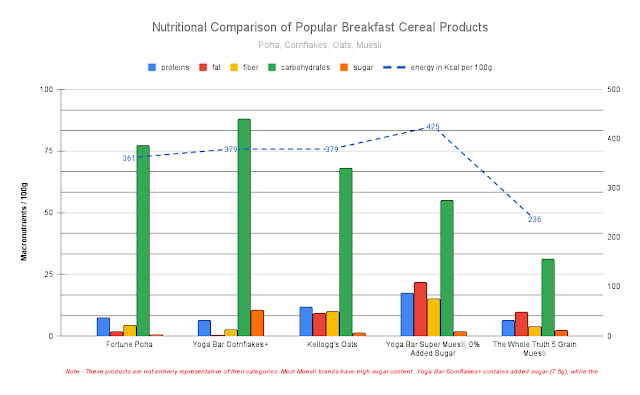Uncovering the Best Nuts and Seeds for Protein 💪🌻
I analyzed 68 products (with known nutrition facts as of July 14, 2024) in the Nuts & Seeds category of the India database on Open Food Facts, often referred to as the 'Wikipedia of food.' The data, sourced from Open Food Facts and subsequently cleaned, is available on GitHub in CSV format. You can also explore the curated dataset using the Flat Viewer tool.
 |
| View, Sort, Filter the data in Flat Viewer |
In a market dominated by ultra-processed foods (UPFs), protein-rich nuts and seeds offer a healthier snacking alternative.
The following chart shows the macro-nutrient comparison of different nuts & seeds -
The data for the products is sourced from OpenFoodFacts.org & Amazon.in -
- Organic Tattva, Organic Peanuts
- Jewel Farmer Sunflower Seeds
- Urban Platter Roasted Salted California Pistachios
- Kalbavi Cashews
- proV California Almonds
- Nutraj California Walnut Kernels
- True Elements Chia Seeds
- Farmley Pumpkin Seeds
- Tata Sampann Flax Seeds
- Happilo Raw Melon Seeds
- SFT Black Sesame Seeds
- Sattviko Fox Nuts (Phool Makhana)
Brands mentioned in the chart are representative examples for a category, not endorsements. Non-standard weights make price comparison challenging for shoppers.
Shelf life of nuts & seeds ranges from 6 months to a year.
Nuts & seeds fall under the Food Safety and Standards Authority of India (FSSAI) category 04 – Fruits and vegetables (including mushrooms and fungi, roots and tubers, fresh pulses and legumes, and aloe vera), seaweeds, and nuts and seeds, with the sub-category 04.1.2.2 while Seeds are categorized under 4.2.2. Packaged Chia Seeds are tagged under 6.1.
Since nuts are common allergens, their packaging is required to display allergen warnings.
Note - This research was based on Open Food Facts & Amazon.in data available as of August 26, 2024. Information on product packaging may change; for the most current details, consult the latest data.
Fun facts:
* Peanuts are grown underground, unlike most other nuts.
* Sunflower seeds are a good source of magnesium, which can help promote a healthy mood.
* Cashews & Pistachios are technically fruits, not nuts. Peanuts aren't actually nuts either; they're legumes.
* The shells of cashews contain a toxic oil that can cause irritation.
* Pistachios are known as the "smiling nut" in China and the "happy nut" in Iran because of their naturally split shell that resembles a smile.
* Almond trees are part of the same family as peach trees. Almonds need bees to pollinate them in order to grow. Studies show that just 60g of almonds (around 22, or a handful) a day could lower oxidative stress that leads to ageing and improve your health span.
* Walnuts are the oldest known tree food, dating back to 10,000 BC. They are also known as “brain food” due to their brain-like appearance and high content of omega-3 fatty acids, which are good for brain health.
* Pumpkin seeds contain phytosterols, which may help lower LDL cholesterol levels, promoting heart health. They are a natural source of tryptophan, an amino acid that helps promote sleep.
* Chia seeds are a good source of fiber. They can absorb up to 10 times their weight in water, making them a popular ingredient in puddings and smoothies.
* Flax seeds are rich in lignans, which are plant compounds that have antioxidant and estrogen properties, potentially reducing the risk of certain cancers. The high fiber content in flax seeds can support digestive health and help prevent constipation.
* Watermelon seeds are rich in vitamins and minerals, including vitamin B, magnesium, and zinc.
* Sesame seeds contain unique lignans called sesamin and sesamolin, which have antioxidant and anti-inflammatory properties.
* Sesame seeds are the primary ingredient in tahini, a paste used in hummus and other Middle Eastern dishes, adding a rich, nutty flavor.
* China produces more pumpkins and pumpkin seeds than any other country.
* Fox nuts, also known as makhana, are a popular snack in India. Fox nuts have been used in Ayurvedic medicine for their potential benefits in improving digestion, strengthening the spleen, and promoting overall health.
* As of 2025, India is the top buyer of U.S. almonds and pistachios, or "badam-pista," purchasing 70% and 90% of U.S. exports respectively. 90% of U.S. tree nuts are cultivated in California.
Also see -



Comments
Post a Comment